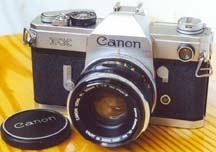|
The Canon FX was introduced in 1964 and established the body
style and control layout that would be used in all other Canon SLRs for
the next 12 years, including the Pellix, FT, FTb, and F-1.

Canon FX #347377 |
This was Canon's second SLR with a built-in light meter. This meter
and its predecessor, however, did not measure the light that passed through
the lens. Light was measured through the circular "electric-eye" window
which appears on the upper right portion of the body. The appropriate
f-stop is read from another rectangular window, which is mounted
on the top of the body, behind and to the left of the rewind crank.
|
This meter incorporates two operational ranges, which may be thought of
as being for indoor (Low) or outdoor (High) use. The photographer must
turn-on the meter using a switch that appears on the back of the body, and
then select the appropriate operational range using a two-position switch,
which is concentric with the rewind crank.
Shutter Speed Selection
Available shutter speeds range from 1/1000 to 1 second with separate
B and X settings. An ASA (ISO) film speed selector
is concentric with the shutter speed dial on the top left of the camera.
Film speed is selected by lifting and then turning the outer ring which
surrounds the shutter speed selector. The film speed selector is graduated
for both DIN and ASA (ISO) speeds. To set exposure on this camera, the
photographer would first select a shutter speed on the shutter speed
selector dial, and then set the lens aperture according to the light
meter readout window.
New Lenses
The FX also introduced the FL series of lenses, which were the first
Canon lenses to offer automatic stop-down when the shutter is tripped.
Previous Canon lenses had been designed primarily for range-finder cameras,
which did not require this feature since the lens was not a component of
the focusing mechanism.
This camera and other Canon SLRs utilizing the same body style (i.e.
Pellix, FT, FTb, et al) were designed to use a 1.3 volt mercury battery
which is no longer available. The modern substitute for this battery is
a 1.5 volt PX 625A. The higher voltage of the substitute battery causes
the camera to meter more light than is actually available, resulting in
under-exposure of the image. This under-exposure is approximately equal
to one and a half stops of the apperture ring. In order to compensate
for this error in the meter, the photographer should first set the camera
to the aperture as indicated by the meter, and then widen the aperture by
one and one half stops. If the meter says, for example, that the film
should be exposed at f/4 for 1/60 of a second, proper exposure
would result after setting the camera for f/2.5 at the same
shutter speed.
An alternative method of obtaining correct readings with this meter
would be to adjust the speed of the film (as recorded on the
film speed selector). To utilize this method,
first take the ISO film speed and divide by 5. Then multiply the
result by 2. Finally, set the film speed selector for the result of this
calculation. As an example, suppose that you are using a film that is
rated at ISO 400. You would divide the actual film speed (400) by 5
(yielding a quotient of 80) and then, after multiplying the quotient by 2,
obtain an adjusted film speed of 160. If the film speed selector is then
set for ASA 160 the meter will yield an accurate f-stop reading.
The battery compartment of the FX is located on the right end of the
body, beneath the rewind crank.
Production History
The FX was produced for one year, being replaced in 1965 by the Pellix,
which was Canon's first SLR to feature through-the-lens (TTL) light
metering. The FP, which was produced in 1964 and 1965, was basically
identical to the FX with the exception that the FP has no light
meter. In 1966, Canon replaced both the FP and the Pellix with their
new FT, which remained in the lineup until 1971, when it was replaced
by the FTb.
The Pellix was remarkable in the respect that the reflex mirror in
this camera remained in place during film exposure. (The reflex mirror
of other SLRs lifts up during exposure to allow light to reach the focal
plane.). This remarkable design was achieved through the use of a
pellicle mirror, which divided the light into two fractions, reflecting
one fraction upward into the pentaprism, while allowing the second
fraction to pass to the focal plane. This resulted in a virtually
vibration-free camera, but was unsuccessful in the market since it
effectively reduced the maximum aperture of every lens by one full
stop, resulting in a less-than-satisfactory amount of light for
either focusing or exposure.
|